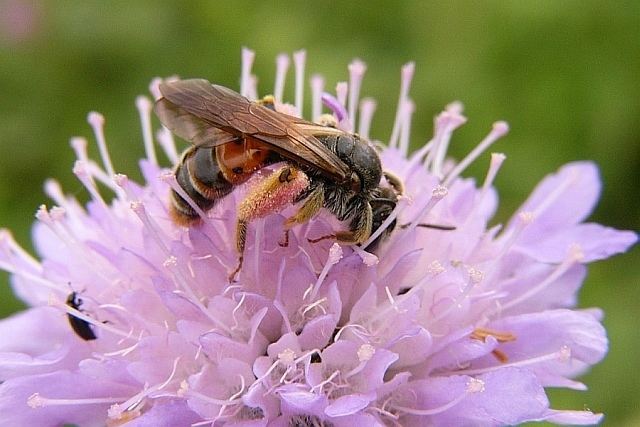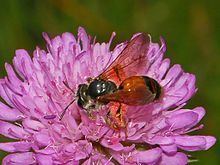Subphylum Hexapoda | Rank Species | |
 | ||
Similar Andrena marginata, Andrena haemorrhoa, Nomada armata, Andrena humilis, Andrena | ||
Scabious bees andrena hattorfiana feeding on field scabious knautia arvensis
Andrena hattorfiana is a species of mining bees belonging to the family Andrenidae subfamily Andreninae.
Contents
- Scabious bees andrena hattorfiana feeding on field scabious knautia arvensis
- Andrena hattorfiana sur knautia arvensis
- Description
- Behavior
- Distribution
- References
Andrena hattorfiana sur knautia arvensis
Description

The adults grow up to 13–16 millimetres (0.51–0.63 in) long. They have a black-brown body with sparse light hair, while the first and the second abdominal segment are reddish. The females have a pollen basket of curved hairs on the sides of the thorax.
Behavior

Andrena hattorfiana is an oligolectic species, feeding its young only on pollen of a few species of Dipsacaceae (Knautia arvensis, Scabiosa columbaria, Centaurea species). It is a solitary bee that can be seen easily from up to 5 meters away. It can be encountered from May through August.

The females usually lay eggs in a nest excavated by themselves in sandy soils. Nest has five to ten brood cells, each having one egg and one pollen pollen as food for the larvae. Every day there is one offspring produced in good weather conditions for foraging, and five to ten in a lifetime. These nests are made in dry parts of a traditionally managed hay field in medium pressure horse-graze pastures with sparse vegetation and on human-trampled paths. These bees relies heavily on pollen, that is almost like a species saving resource. The critical pollen resource for 10 reproducing A. hattorfiana ♀ varied from 27 to 361 plant individuals. Therefore, being able to get pollen from only one flower may have helped lead this species to the endangerment of being extinct.
Distribution

This endangered solitary bee is present in most of Europe and in the Near East. It is mainly found in Sweden but is threatened in several European countries. The overall population sizes of this bee are small.
With the specific conditions in which a nest must be made could have aided in bringing this species closer to being endangered of being extinct. Furthermore, this species is endangered as these bees are often infected by a host specific cleptoparasite called Nomada armata which parasitizes a big proportion of brood cells in local populations. Other factors are the competition for pollen by other insects, and habitat loss and fragmentation. But the main reason is the reduced food-plant distribution because of larger farm units and not a lot of traditionally managed meadows.
Therefore, Andrena hattorfiana is endangered because of pollen competition, not enough variability in their habitat, and because of there not being enough traditionally managed meadows.
